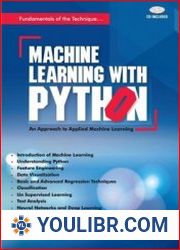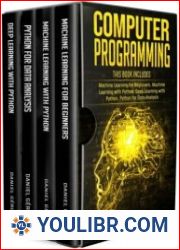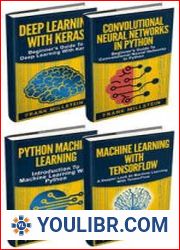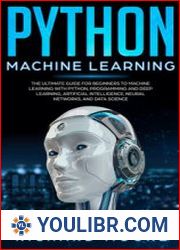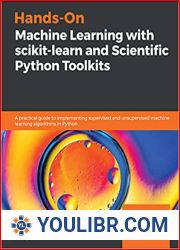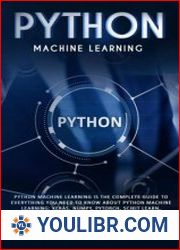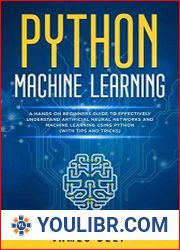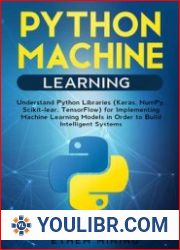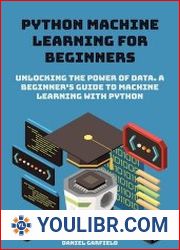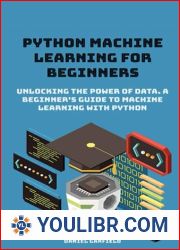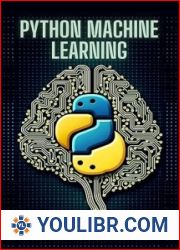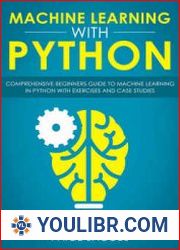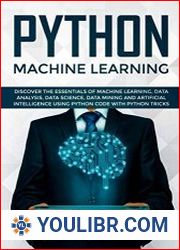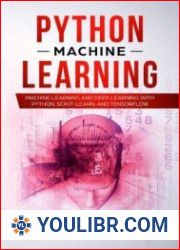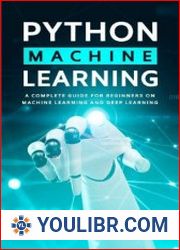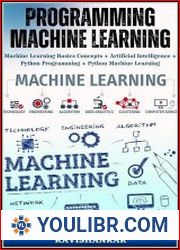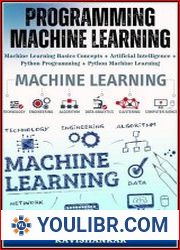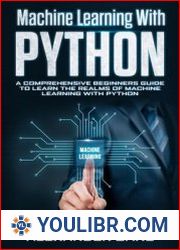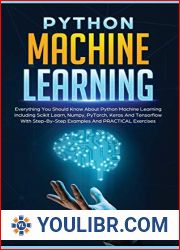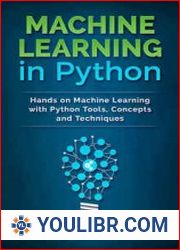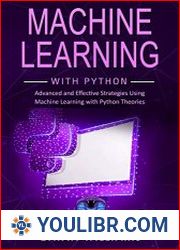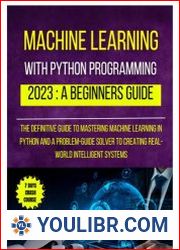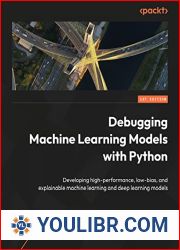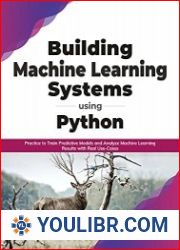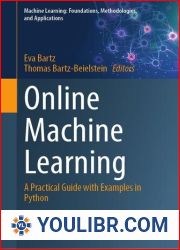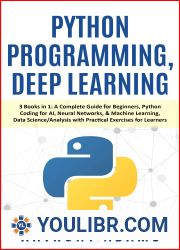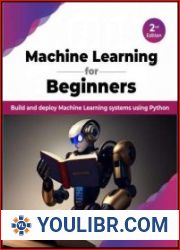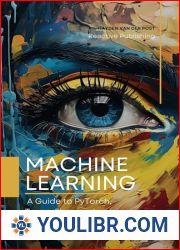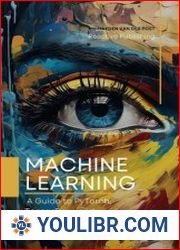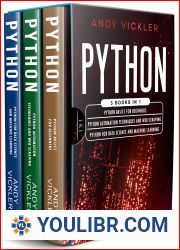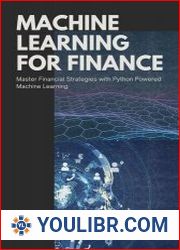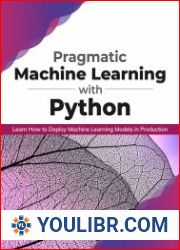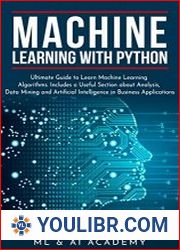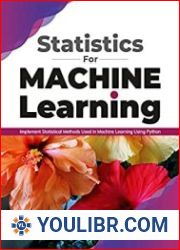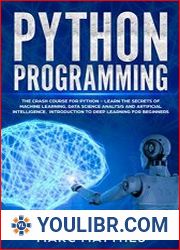
BOOKS - PROGRAMMING - Machine Learning with Python

Machine Learning with Python
Author: Abhishek Vijayvargia
Year: 2018
Format: PDF | DJVU
File size: 10.1 MB
Language: ENG

Year: 2018
Format: PDF | DJVU
File size: 10.1 MB
Language: ENG

Book Machine Learning with Python Introduction: In today's fast-paced technological era, it is crucial to understand the process of technology evolution and its impact on human society. The book "Machine Learning with Python" provides an in-depth understanding of the concepts and techniques of machine learning, which is a subset of artificial intelligence that enables computers to learn from experience and improve their performance on a task without being explicitly programmed. This book offers a comprehensive approach to mastering machine learning techniques using Python, one of the most widely used and accepted programming languages in the field. Chapter 1: Fundamentals of Machine Learning The first chapter begins by introducing the fundamental concepts of machine learning, including supervised and unsupervised learning, regression, classification, clustering, and neural networks. These concepts are explained through real-world examples, providing readers with a solid foundation to build upon. The chapter also covers the importance of feature selection, data preprocessing, and model evaluation, emphasizing the significance of these steps in the machine learning process. Chapter 2: Linear Regression Linear regression is the second topic covered in the book, where the authors delve into the mathematical explanations of linear regression, including the cost function, gradient descent, and the optimal solution. The chapter also explores the advantages and disadvantages of linear regression, making it easier for readers to understand its limitations and applications. Chapter 3: Logistic Regression Logistic regression is the next topic discussed in the book, focusing on the logistic function, probability calculation, and the logistic loss function. The authors provide practical examples of logistic regression, enabling readers to grasp the concept's application in real-world scenarios.
Book Machine arning with Python Введение: В современную быстро развивающуюся технологическую эру крайне важно понимать процесс эволюции технологий и его влияние на человеческое общество. Книга «Машинное обучение с Python» дает глубокое понимание концепций и техник машинного обучения, которое представляет собой подмножество искусственного интеллекта, позволяющее компьютерам учиться на опыте и повышать свою производительность при выполнении задачи без явного программирования. Эта книга предлагает комплексный подход к освоению техник машинного обучения с использованием Python, одного из наиболее широко используемых и принятых в данной области языков программирования. Глава 1: Основы машинного обучения Первая глава начинается с введения фундаментальных концепций машинного обучения, включая обучение с учителем и без учителя, регрессию, классификацию, кластеризацию и нейронные сети. Эти концепции объясняются на реальных примерах, предоставляя читателям прочную основу для развития. Глава также охватывает важность выбора признаков, предварительной обработки данных и оценки модели, подчеркивая важность этих шагов в процессе машинного обучения. Глава 2: Линейная регрессия Линейная регрессия является второй темой, рассматриваемой в книге, где авторы углубляются в математические объяснения линейной регрессии, включая функцию стоимости, градиентный спуск и оптимальное решение. В главе также рассматриваются преимущества и недостатки линейной регрессии, облегчающие читателям понимание её ограничений и применений. Глава 3: Логистическая регрессия Логистическая регрессия является следующей темой, обсуждаемой в книге, с акцентом на логистическую функцию, расчет вероятности и функцию логистических потерь. Авторы приводят практические примеры логистической регрессии, позволяющие читателям понять применение концепции в реальных сценариях.
Book Machine arning with Python Introduction : Dans une ère technologique moderne en évolution rapide, il est essentiel de comprendre le processus d'évolution de la technologie et son impact sur la société humaine. livre « Machine arning with Python » fournit une compréhension approfondie des concepts et des techniques de Machine arning, qui est un sous-ensemble de l'intelligence artificielle qui permet aux ordinateurs d'apprendre de l'expérience et d'améliorer leurs performances tout en exécutant une tâche sans programmation explicite. Ce livre propose une approche intégrée de la maîtrise des techniques d'apprentissage automatique en utilisant Python, l'un des langages de programmation les plus utilisés et les plus acceptés dans le domaine. Chapitre 1 : s bases de l'apprentissage automatique premier chapitre commence par l'introduction des concepts fondamentaux de l'apprentissage automatique, y compris l'apprentissage avec et sans professeur, la régression, la classification, le regroupement et les réseaux neuronaux. Ces concepts sont expliqués à partir d'exemples concrets, offrant aux lecteurs une base solide pour le développement. chapitre traite également de l'importance du choix des caractéristiques, du prétraitement des données et de l'évaluation du modèle, soulignant l'importance de ces étapes dans le processus d'apprentissage automatique. Chapitre 2 : Régression linéaire La régression linéaire est le deuxième sujet traité dans le livre, où les auteurs examinent en profondeur les explications mathématiques de la régression linéaire, y compris la fonction de coût, la descente de gradient et la solution optimale. chapitre examine également les avantages et les inconvénients de la régression linéaire, ce qui permet aux lecteurs de comprendre ses limites et ses applications. Chapitre 3 : Régression logistique La régression logistique est le prochain sujet traité dans le livre, en mettant l'accent sur la fonction logistique, le calcul de probabilité et la fonction de perte logistique. s auteurs donnent des exemples pratiques de régression logistique qui permettent aux lecteurs de comprendre l'application du concept dans des scénarios réels.
Book Machine arning with Python Introducción: En la era tecnológica actual, en rápida evolución, es fundamental comprender el proceso de evolución de la tecnología y su impacto en la sociedad humana. libro «Machine arning with Python» proporciona una comprensión profunda de los conceptos y técnicas de machine learning, que es un subconjunto de inteligencia artificial que permite a los ordenadores aprender de la experiencia y mejorar su rendimiento cuando realizan una tarea sin programación explícita. Este libro ofrece un enfoque integral para dominar las técnicas de aprendizaje automático utilizando Python, uno de los lenguajes de programación más utilizados y aceptados en este campo. Capítulo 1: Fundamentos del aprendizaje automático primer capítulo comienza con la introducción de conceptos fundamentales del aprendizaje automático, incluyendo el aprendizaje con y sin maestro, regresión, clasificación, agrupamiento y redes neuronales. Estos conceptos se explican con ejemplos reales, proporcionando a los lectores una base sólida para el desarrollo. capítulo también cubre la importancia de la selección de características, el procesamiento previo de datos y la evaluación del modelo, destacando la importancia de estos pasos en el proceso de aprendizaje automático. Capítulo 2: Regresión lineal La regresión lineal es el segundo tema tratado en el libro, donde los autores profundizan en las explicaciones matemáticas de la regresión lineal, incluyendo la función de costo, el descenso gradiente y la solución óptima. capítulo también examina las ventajas y desventajas de la regresión lineal, lo que facilita a los lectores comprender sus limitaciones y aplicaciones. Capítulo 3: Regresión logística La regresión logística es el siguiente tema tratado en el libro, con énfasis en la función logística, el cálculo de probabilidad y la función de pérdida logística. autores ofrecen ejemplos prácticos de regresión logística que permiten a los lectores comprender la aplicación del concepto en escenarios reales.
Book Machine arning with Python Introdução: Na era tecnológica moderna, é crucial compreender a evolução da tecnologia e seus efeitos na sociedade humana. O livro «Aprendizado de máquina com Python» oferece uma compreensão profunda dos conceitos e uma técnica de aprendizado de máquina, que é um subconjunto de inteligência artificial que permite aos computadores aprender com a experiência e melhorar sua produtividade em uma tarefa sem programação clara. Este livro oferece uma abordagem completa do aprendizado de máquinas usando Python, uma das linguagens de programação mais utilizadas e adotadas nesta área. Capítulo 1: Fundamentos da aprendizagem de máquinas O primeiro capítulo começa com a introdução de conceitos fundamentais de aprendizado de máquina, incluindo o ensino com o professor e sem o professor, regressão, classificação, clusterização e redes neurais. Estes conceitos são explicados por exemplos reais, oferecendo aos leitores uma base sólida para o desenvolvimento. O capítulo também abrange a importância da seleção de sinais, do pré-processamento de dados e da avaliação do modelo, destacando a importância destes passos no processo de aprendizagem automática. Capítulo 2: Regressão linear Regressão linear é o segundo tema tratado no livro, onde os autores se aprofundam em explicações matemáticas para a regressão linear, incluindo a função de custo, descida gradiente e a solução ideal. O capítulo também aborda os benefícios e desvantagens da regressão linear, facilitando a compreensão dos leitores sobre suas limitações e aplicações. Capítulo 3: Regressão logística Regressão logística é o seguinte tema a ser discutido no livro, com foco na função logística, no cálculo da probabilidade e na função de perdas logísticas. Os autores citam exemplos práticos de regressão logística que permitem aos leitores compreender a aplicação do conceito em cenários reais.
Book Machine arning with Python Introduzione: In un'era tecnologica in continua evoluzione, è fondamentale comprendere l'evoluzione della tecnologia e il suo impatto sulla società umana. Il libro «Apprendimento automatico con Python» offre una profonda comprensione dei concetti e una tecnica di apprendimento automatico, che è un sottoinsieme di intelligenza artificiale che permette ai computer di imparare dall'esperienza e migliorare le loro prestazioni nel compimento di un'attività senza una programmazione chiara. Questo libro offre un approccio completo alla tecnologia di apprendimento automatico utilizzando Python, uno dei linguaggi di programmazione più utilizzati e accettati in questo campo. Capitolo 1: basi dell'apprendimento automatico Il primo capitolo inizia con l'introduzione di concetti fondamentali per l'apprendimento automatico, tra cui l'apprendimento con e senza insegnante, la regressione, la classificazione, il clustering e le reti neurali. Questi concetti sono spiegati su esempi reali, fornendo ai lettori una base solida per lo sviluppo. Il capitolo comprende anche l'importanza della selezione dei segni, del pre-elaborazione dei dati e della valutazione del modello, sottolineando l'importanza di questi passi nel processo di apprendimento automatico. Capitolo 2: Regressione lineare Regressione lineare è il secondo tema affrontato nel libro, dove gli autori approfondiscono le spiegazioni matematiche della regressione lineare, inclusa la funzione del costo, la discesa gradiente e la soluzione ottimale. Il capitolo affronta anche i vantaggi e gli svantaggi della regressione lineare, che facilitano la comprensione dei suoi limiti e delle sue applicazioni. Capitolo 3: Regressione logistica La regressione logistica è il seguente argomento affrontato nel libro, con un focus sulla logistica, il calcolo delle probabilità e la funzione delle perdite logistiche. Gli autori forniscono esempi pratici di regressione logistica che permettono ai lettori di comprendere l'applicazione del concetto in scenari reali.
Buchmaschine rnen mit Python Einleitung: In der heutigen schnelllebigen technologischen Ära ist es entscheidend, den Prozess der technologischen Evolution und ihre Auswirkungen auf die menschliche Gesellschaft zu verstehen. Das Buch Machine arning with Python bietet einen tiefen Einblick in die Konzepte und Techniken des maschinellen rnens, eine Teilmenge der künstlichen Intelligenz, die es Computern ermöglicht, aus Erfahrungen zu lernen und ihre istung zu verbessern, wenn sie eine Aufgabe ohne explizite Programmierung ausführen. Dieses Buch bietet einen umfassenden Ansatz zur Beherrschung der Techniken des maschinellen rnens mit Python, einer der am weitesten verbreiteten und akzeptierten Programmiersprachen auf dem Gebiet. Kapitel 1: Grundlagen des maschinellen rnens Das erste Kapitel beginnt mit der Einführung grundlegender Konzepte des maschinellen rnens, darunter das rnen mit und ohne hrer, Regression, Klassifizierung, Clustering und neuronale Netze. Diese Konzepte werden anhand realer Beispiele erklärt und bieten den sern eine solide Grundlage für die Entwicklung. Das Kapitel behandelt auch die Bedeutung der Merkmalsauswahl, der Datenvorverarbeitung und der Modellauswertung und unterstreicht die Bedeutung dieser Schritte im maschinellen rnprozess. Kapitel 2: Lineare Regression Die lineare Regression ist das zweite Thema, das in dem Buch behandelt wird, in dem die Autoren in die mathematischen Erklärungen der linearen Regression eintauchen, einschließlich der Kostenfunktion, des Gradientenabstiegs und der optimalen Lösung. Das Kapitel befasst sich auch mit den Vor- und Nachteilen der linearen Regression, die es den sern erleichtern, ihre Einschränkungen und Anwendungen zu verstehen. Kapitel 3: Logistische Regression Die logistische Regression ist das nächste Thema, das im Buch diskutiert wird, wobei der Schwerpunkt auf der logistischen Funktion, der Wahrscheinlichkeitsberechnung und der Funktion der logistischen Verluste liegt. Die Autoren geben praktische Beispiele für logistische Regression, die es den sern ermöglichen, die Anwendung des Konzepts in realen Szenarien zu verstehen.
''
Python ile Kitap Makine Öğrenimi Giriş: Günümüzün hızla gelişen teknolojik çağında, teknolojinin evrimini ve insan toplumu üzerindeki etkisini anlamak çok önemlidir. "Python ile Makine Öğrenimi" kitabı, bilgisayarların deneyimden öğrenmelerini ve açık programlama olmadan bir görevdeki performanslarını geliştirmelerini sağlayan yapay zekanın bir alt kümesi olan makine öğrenimi kavram ve tekniklerinin derinlemesine anlaşılmasını sağlar. Bu kitap, alandaki en yaygın kullanılan ve kabul gören programlama dillerinden biri olan Python'u kullanarak makine öğrenme tekniklerine hakim olmak için kapsamlı bir yaklaşım sunmaktadır. Bölüm 1: Makine Öğreniminin Temelleri İlk bölüm, denetlenen ve denetlenmeyen öğrenme, regresyon, sınıflandırma, kümeleme ve sinir ağları dahil olmak üzere temel makine öğrenimi kavramlarının tanıtılmasıyla başlar. Bu kavramlar gerçek dünyadaki örneklerle açıklanır ve okuyuculara gelişim için sağlam bir temel sağlar. Bu bölüm ayrıca özellik seçimi, veri ön işleme ve model değerlendirmenin önemini ele almakta ve bu adımların makine öğrenme sürecindeki önemini vurgulamaktadır. Bölüm 2: Doğrusal Regresyon Doğrusal regresyon, kitapta ele alınan ikinci konudur; burada yazarlar, maliyet fonksiyonu, gradyan inişi ve optimal çözüm dahil olmak üzere doğrusal regresyonun matematiksel açıklamalarını araştırırlar. Bölüm ayrıca, doğrusal regresyonun avantajlarını ve dezavantajlarını tartışarak, okuyucuların sınırlamalarını ve uygulamalarını anlamalarını kolaylaştırır. Bölüm 3: Lojistik regresyon Lojistik regresyon, lojistik fonksiyon, olasılık hesaplaması ve lojistik kayıp fonksiyonuna odaklanan, kitapta tartışılan bir sonraki konudur. Yazarlar, okuyucuların kavramın gerçek dünya senaryolarında uygulanmasını anlamalarını sağlayan pratik lojistik regresyon örnekleri sunmaktadır.
كتاب التعلم الآلي مع مقدمة بايثون: في العصر التكنولوجي سريع التطور اليوم، من الضروري فهم تطور التكنولوجيا وتأثيرها على المجتمع البشري. يوفر كتاب «التعلم الآلي مع بايثون» فهمًا عميقًا لمفاهيم وتقنيات التعلم الآلي، وهي مجموعة فرعية من الذكاء الاصطناعي تسمح لأجهزة الكمبيوتر بالتعلم من التجربة وتحسين أدائها في مهمة دون برمجة صريحة. يقدم هذا الكتاب نهجًا شاملاً لإتقان تقنيات التعلم الآلي باستخدام Python، إحدى لغات البرمجة الأكثر استخدامًا وقبولًا في هذا المجال. الفصل 1: أساسيات التعلم الآلي يبدأ الفصل الأول بإدخال مفاهيم التعلم الآلي الأساسية، بما في ذلك التعلم الخاضع للإشراف وغير الخاضع للإشراف، والانحدار، والتصنيف، والتجمع، والشبكات العصبية. يتم شرح هذه المفاهيم من خلال أمثلة واقعية، مما يوفر للقراء أساسًا متينًا للتنمية. يغطي الفصل أيضًا أهمية اختيار الميزات، ومعالجة البيانات مسبقًا، وتقييم النماذج، مما يسلط الضوء على أهمية هذه الخطوات في عملية التعلم الآلي. الفصل 2: الانحدار الخطي هو الموضوع الثاني الذي يغطيه الكتاب، حيث يتعمق المؤلفون في التفسيرات الرياضية للانحدار الخطي، بما في ذلك دالة التكلفة، وهبوط التدرج، والحل الأمثل. يناقش الفصل أيضًا مزايا وعيوب الانحدار الخطي، مما يسهل على القراء فهم حدوده وتطبيقاته. الفصل 3: الانحدار اللوجستي الانحدار اللوجستي هو الموضوع التالي الذي نوقش في الكتاب، مع التركيز على الوظيفة اللوجستية وحساب الاحتمالات ووظيفة الخسارة اللوجستية. يقدم المؤلفون أمثلة عملية للانحدار اللوجستي، مما يسمح للقراء بفهم تطبيق المفهوم في سيناريوهات العالم الحقيقي.







